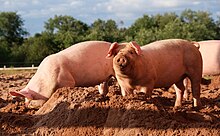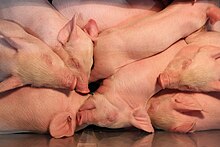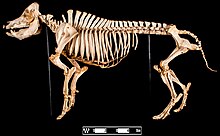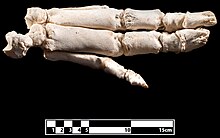
A | B | C | D | E | F | G | H | CH | I | J | K | L | M | N | O | P | Q | R | S | T | U | V | W | X | Y | Z | 0 | 1 | 2 | 3 | 4 | 5 | 6 | 7 | 8 | 9
| Pig | |
|---|---|

| |
| Domestic pigs | |
Domesticated
| |
| Scientific classification | |
| Domain: | Eukaryota |
| Kingdom: | Animalia |
| Phylum: | Chordata |
| Class: | Mammalia |
| Order: | Artiodactyla |
| Family: | Suidae |
| Genus: | Sus |
| Species: | S. domesticus
|
| Binomial name | |
| Sus domesticus Erxleben, 1777
| |
| Synonyms[1] | |
The pig (Sus domesticus), also called swine (pl.: swine) or hog, is an omnivorous, domesticated, even-toed, hoofed mammal. It is named the domestic pig when distinguishing it from other members of the genus Sus. It is considered a subspecies of Sus scrofa (the wild boar or Eurasian boar) by some authorities, but as a distinct species by others. Pigs were domesticated in the Neolithic, both in East Asia and in the Near East. When domesticated pigs arrived in Europe, they extensively interbred with wild boar but retained their domesticated features.
Pigs are farmed primarily for meat, called pork. The animal's skin or hide is used for leather. China is the world's largest pork producer, followed by the European Union and then the United States. Around 1.5 billion pigs are raised each year, producing some 120 million tonnes of meat, often cured as bacon. Some are kept as pets.
Pigs have featured in human culture since Neolithic times, appearing in art and literature for children and adults, and celebrated in cities such as Bologna for their meat products.
Description
The pig has a large head, with a long snout strengthened by a special prenasal bone and a disk of cartilage at the tip.[2] The snout is used to dig into the soil to find food and is an acute sense organ. The dental formula of adult pigs is 3.1.4.33.1.4.3, giving a total of 44 teeth. The rear teeth are adapted for crushing. In males, the canine teeth can form tusks, which grow continuously and are sharpened by grinding against each other.[2] There are four hoofed toes on each foot; the two larger central toes bear most of the weight, while the outer two are also used in soft ground.[3] Most pigs have rather sparsely bristled hair on their skin, though there are some woolly-coated breeds such as the Mangalitsa.[4] Adult pigs generally weigh between 140 and 300 kg (310 and 660 lb), though some breeds can exceed this range. Exceptionally, a pig called Big Bill weighed 1,157 kg (2,551 lb) and had a shoulder height of 1.5 m (4.9 ft).[5]
Pigs possess both apocrine and eccrine sweat glands, although the latter are limited to the snout.[6] Pigs, like other "hairless" mammals such as elephants, do not use thermal sweat glands in cooling.[7] Pigs are less able than many other mammals to dissipate heat from wet mucous membranes in the mouth by panting. Their thermoneutral zone is 16–22 °C (61–72 °F).[8] At higher temperatures, pigs lose heat by wallowing in mud or water via evaporative cooling, although it has been suggested that wallowing may serve other functions, such as protection from sunburn, ecto-parasite control, and scent-marking.[9] Pigs are among four mammalian species with mutations in the nicotinic acetylcholine receptor that protect against snake venom. Mongooses, honey badgers, hedgehogs, and pigs all have different modifications to the receptor pocket which prevents α-neurotoxin from binding.[10] Pigs have small lungs for their body size, and are thus more susceptible than other domesticated animals to fatal bronchitis and pneumonia.[11] The genome of the pig has been sequenced; it contains about 22,342 protein-coding genes.[12][13][14]
-
Skeleton
-
Skull
-
Bones of the foot
Evolution
Phylogeny
Domestic pigs are related to other pig species as shown in the cladogram, based on phylogenetic analysis using mitochondrial DNA.[15]
Taxonomy
The pig is most often considered to be a subspecies of the wild boar, which was given the name Sus scrofa by Carl Linnaeus in 1758; following from this, the formal name of the pig is Sus scrofa domesticus.[16][17] However, in 1777, Johann Christian Polycarp Erxleben classified the pig as a separate species from the wild boar. He gave it the name Sus domesticus, still used by some taxonomists.[18] The American Society of Mammalogists considers it a separate species.[19]
Domestication in the Neolithic

Archaeological evidence shows that pigs were domesticated from wild boar in the Near East in or around the Tigris Basin,[21] being managed in a semi-wild state much as they are managed by some modern New Guineans.[22] There were pigs in Cyprus more than 11,400 years ago, introduced from the mainland, implying domestication in the adjacent mainland by then.[23] Pigs were separately domesticated in China, starting some 8,000 years ago.[24][25][26] In the Near East, pig husbandry spread for the next few millennia. It reduced gradually during the Bronze Age, as rural populations instead focused on commodity-producing livestock, but it was sustained in cities.[27]
Domestication did not involve reproductive isolation with population bottlenecks. Western Asian pigs were introduced into Europe, where they crossed with wild boar. There appears to have been interbreeding with a now extinct ghost population of wild pigs during the Pleistocene. The genomes of domestic pigs show strong selection for genes affecting behavior and morphology. Human selection for domestic traits likely counteracted the homogenizing effect of gene flow from wild boars and created domestication islands in the genome.[28][29] Pigs arrived in Europe from the Near East at least 8,500 years ago. Over the next 3,000 years they interbred with European wild boar until their genome showed less than 5% Near Eastern ancestry, yet retained their domesticated features.[30]
DNA evidence from subfossil remains of teeth and jawbones of Neolithic pigs shows that the first domestic pigs in Europe were brought from the Near East. This stimulated the domestication of local European wild boar, resulting in a third domestication event with the Near Eastern genes dying out in European pig stock. More recently there have been complex exchanges, with European domesticated lines being exported, in turn, to the ancient Near East.[31][32] Historical records indicate that Asian pigs were again introduced into Europe during the 18th and early 19th centuries.[25]
History
Columbian Exchange
Among the animals that the Spanish introduced to the Chiloé Archipelago in the 16th century Columbian Exchange, pigs were the most successful in adapting to local conditions. The pigs benefited from abundant shellfish and algae exposed by the large tides of the archipelago.[33] Pigs were brought to southeastern North America from Europe by de Soto and other early Spanish explorers. Escaped pigs became feral.[34]
Feral pigs

Pigs have escaped from farms and gone feral in many parts of the world. Feral pigs in the southeastern United States have migrated north to the Midwest, where many state agencies have programs to remove them.[35][36][37] Feral pigs in New Zealand and northern Queensland have caused substantial environmental damage.[38][39] Feral hybrids of the European wild boar with the domestic pig are disruptive to both environment and agriculture, as they destroy crops, spread animal diseases including Foot-and-mouth disease, and consume wildlife such as juvenile seabirds and young tortoises.[40] Feral pig damage is especially an issue in southeastern South America.[41][42]
Reproduction
Physiology
Female pigs reach sexual maturity at 3–12 months of age and come into estrus every 18–24 days if they are not successfully bred. The variation in ovulation rate can be attributed to intrinsic factors such as age and genotype, as well as extrinsic factors like nutrition, environment, and the supplementation of exogenous hormones. The gestation period averages 112–120 days.[43]

Estrus lasts two to three days, and the female's displayed receptiveness to mate is known as standing heat. Standing heat is a reflexive response that is stimulated when the female is in contact with the saliva of a sexually mature boar. Androstenol is one of the pheromones produced in the submaxillary salivary glands of boars that trigger the female's response.[44] The female cervix contains a series of five interdigitating pads, or folds, that hold the boar's corkscrew-shaped penis during copulation.[45] Females have bicornuate uteruses and two conceptuses must be present in both uterine horns to enable pregnancy to proceed.[46] The mother's body recognises that it is pregnant on days 11 to 12 of pregnancy, and is marked by the corpus luteum's producing the sex hormone progesterone.[47] To sustain the pregnancy, the embryo signals to the corpus luteum with the hormones estradiol and prostaglandin E2.[48] This signaling acts on both the endometrium and luteal tissue to prevent the regression of the corpus luteum by activation of genes that are responsible for corpus luteum maintenance.[49] During mid to late pregnancy, the corpus luteum relies primarily on luteinizing hormone for maintenance until birth.[48]
Archeological evidence indicates that medieval European pigs farrowed, or bore a litter of piglets, once per year.[50] By the nineteenth century, European piglets routinely double-farrowed, or bore two litters of piglets per year. It is unclear when this shift occurred.[51] Pigs have a maximum life span of about 27 years.[52]
Nest-building
A characteristic of pigs which they share with carnivores is nest-building. Sows root in the ground to create depressions the size of their body, and then build nest mounds, using twigs and leaves, softer in the middle, in which to give birth. When the mound reaches the desired height, she places large branches, up to 2 metres in length, on the surface. She enters the mound and roots around to create a depression within the gathered material. She then gives birth in a lying position, unlike other artiodactyls which usually stand while birthing.[53]
Nest-building occurs during the last 24 hours before the onset of farrowing, and becomes most intense 12 to 6 hours before farrowing.[54] The sow separates from the group and seeks a suitable nest site with well-drained soil and shelter from rain and wind. This provides the offspring with shelter, comfort, and thermoregulation. The nest provides protection against weather and predators, while keeping the piglets close to the sow and away from the rest of the herd. This ensures they do not get trampled on, and prevents other piglets from stealing milk from the sow.[55] The onset of nest-building is triggered by a rise in prolactin level, caused by a decrease in progesterone and an increase in prostaglandin; the gathering of nest material seems to be regulated more by external stimuli such as temperature.[54]
Nursing and suckling
Pigs have complex nursing and suckling behaviour.[56] Nursing occurs every 50–60 minutes, and the sow requires stimulation from piglets before milk let-down. Sensory inputs (vocalisation, odours from mammary and birth fluids, and hair patterns of the sow) are particularly important immediately post-birth to facilitate teat location by the piglets.[57] Initially, the piglets compete for position at the udder; then the piglets massage around their respective teats with their snouts, during which time the sow grunts at slow, regular intervals. Each series of grunts varies in frequency, tone and magnitude, indicating the stages of nursing to the piglets.[58]
The phase of competition for teats and of nosing the udder lasts for about a minute, ending when milk begins to flow. The piglets then hold the teats in their mouths and suck with slow mouth movements (one per second), and the rate of the sow's grunting increases for approximately 20 seconds. The grunt peak in the third phase of suckling does not coincide with milk ejection, but rather the release of oxytocin from the pituitary into the bloodstream.[59] Phase four coincides with the period of main milk flow (10–20 seconds) when the piglets suddenly withdraw slightly from the udder and start sucking with rapid mouth movements of about three per second. The sow grunts rapidly, lower in tone and often in quick runs of three or four, during this phase. Finally, the flow stops and so does the grunting of the sow. The piglets may dart from teat to teat and recommence suckling with slow movements, or nosing the udder. Piglets massage and suckle the sow's teats after milk flow ceases as a way of letting the sow know their nutritional status. This helps her to regulate the amount of milk released from that teat in future sucklings. The more intense the post-feed massaging of a teat, the more milk that teat later releases.[60]
-
Sows typically have 12–14 nipples.
-
Zdroj:https://en.wikipedia.org?pojem=Hog_(swine)
Text je dostupný za podmienok Creative Commons Attribution/Share-Alike License 3.0 Unported; prípadne za ďalších podmienok. Podrobnejšie informácie nájdete na stránke Podmienky použitia.
Antropológia
Aplikované vedy
Bibliometria
Dejiny vedy
Encyklopédie
Filozofia vedy
Forenzné vedy
Humanitné vedy
Knižničná veda
Kryogenika
Kryptológia
Kulturológia
Literárna veda
Medzidisciplinárne oblasti
Metódy kvantitatívnej analýzy
Metavedy
Metodika
Text je dostupný za podmienok Creative
Commons Attribution/Share-Alike License 3.0 Unported; prípadne za ďalších
podmienok.
Podrobnejšie informácie nájdete na stránke Podmienky
použitia.
www.astronomia.sk | www.biologia.sk | www.botanika.sk | www.dejiny.sk | www.economy.sk | www.elektrotechnika.sk | www.estetika.sk | www.farmakologia.sk | www.filozofia.sk | Fyzika | www.futurologia.sk | www.genetika.sk | www.chemia.sk | www.lingvistika.sk | www.politologia.sk | www.psychologia.sk | www.sexuologia.sk | www.sociologia.sk | www.veda.sk I www.zoologia.sk















